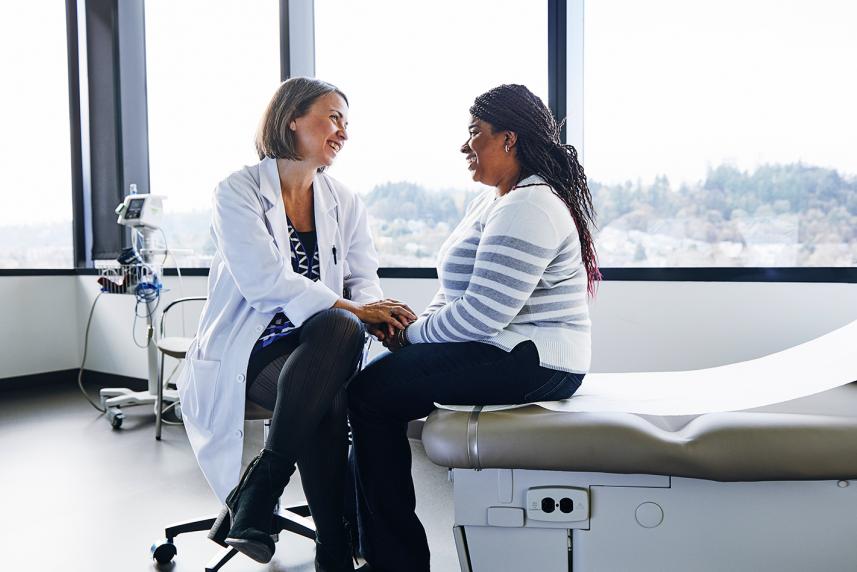
8 medical visits you shouldn’t miss

When life gets busy, health screenings can fall to the bottom of your to-do list. But these potentially life-saving appointments are worth prioritizing.
The COVID-19 pandemic forced us to hit pause on so much more than birthday parties and haircuts. Health checkups were canceled. Prescriptions went unfilled. Cancer screenings were postponed.
If this sounds familiar, you’re not alone. A 2021 American Society for Radiation Oncology survey found that 73% of radiation oncologists said they had patients miss cancer screenings during the pandemic.
Well visits are not only key for managing any health conditions you may have. They can also help prevent them from happening in the first place. So now is as good a time as any to catch up on the visits you may have missed.
Not sure where to start? The appointments and screenings that matter most for you will depend on factors such as your age, race, sex and health history. But here are 8 wellness appointments you should consider making now.
Checkup #1: Your physical (and/or annual wellness visit if you have Medicare)
A visit with your primary care doctor is a great way to check in on your health as a whole. And they can identify health issues early, before they become more severe. At a physical, your doctor might:
- Make sure you’re up to date on vaccinations such as the flu shot or the shingles vaccine.
- Discuss healthy habits. This could include managing stress, eating nutritious foods and movement.
- Check your blood pressure.
- Take blood work to assess your risk of chronic diseases that can fly under the radar. For example, your blood sugar might indicate you have pre-diabetes even though you have no symptoms.
- Treat general issues you’re having, such as a rash or cold.
- Refill or adjust your medication regimen.
If you haven’t seen your primary care doctor in a while, it’s a good idea to make an appointment — even if you feel like you're in good health.
The Optum Store can take the hassle out of managing medications. Sign up for home delivery and access our best prices. No insurance required.
Checkup #2: Mammogram
Breast cancer is the second-most common cancer in American women, after skin cancer. And it’s the second deadliest after lung cancer, according to the American Cancer Society (ACS). Even though this is scary news, there’s hope. Breast cancer is very treatable — especially when it’s caught early.
This is why sticking to the mammogram schedule that you and your doctor set is so important. The ACS recommends that women between the ages of 40 and 44, and at average risk, have the option to start screening with a mammogram every year. Beginning at age 45, women should get mammograms every year until age 54, and every 2 years after that. If you’re at high risk for breast cancer, you should be screened earlier. Risk factors include having a mother, daughter or sister who had breast cancer.
Checkup #3: Cervical cancer screening
Cervical cancer used to be one of the top causes of cancer death for American women. But thanks to the increased use of the Pap test for screening, this is no longer the case. In fact, regular Pap screening has been shown to reduce the chance of developing cervical cancer, or dying from it, by at least 80%, according to the National Cancer Institute. That’s because when pre-cancerous cells are found early, doctors can treat the area to prevent cancer.
Another effective screening choice is called the HPV (human papillomavirus) test. This checks for the high-risk strains of HPV that can lead to cervical cancer. Some versions of the test — called primary HPV tests — have been approved by the FDA to be used alone for screening without the need for a Pap test. (You can screen for other sexually transmitted infections right from home. Learn how.)
For women with no history of cervical cancer or pre-cancer and who are between the ages of 25 and 65, the ACS recommends one of the following:
- A Pap test every 3 years
- A primary HPV test every 5 years
- An HPV test and a Pap test every 5 years
Checkup #4: Colorectal cancer screening
The lifetime risk of developing colorectal cancer is about 1 in 23 for men and 1 in 25 for women, according to the ACS. And it’s the second-most common cause of cancer death in America in men and women combined. The good news: Screening tests help spot pre-cancerous polyps before they become cancerous. They also find colorectal cancer earlier, when it’s easier to treat.
If you’re 45 or older and at average risk, and you’ve never been screened for colorectal cancer, now is the time, says the ACS. A colonoscopy remains the gold standard in screening tests. But there are other options too. Stool-based tests such as the FIT can be done from the comfort of your home. Discuss your options and your risk for colorectal cancer with your doctor. (Shop for more convenient at-home tests here.)
Checkup #5: Dental exam and cleaning
Seeing your dentist and getting your teeth cleaned at least once a year isn’t just about having a nice smile. According to the American Dental Association, taking care of your teeth and gums helps prevent:
- Cavities
- Gum disease
- Tooth loss
- Infection
Regular dentist visits also help spot or prevent other health issues, such as mouth cancer, diabetes and other systemic diseases. Plus, you’ll score a free toothbrush.
Checkup #6: Eye exam
Re-upping your glasses or contacts prescription is only one reason to see the eye doctor. About 93 million American adults are at high risk of serious vision loss, according to the Centers for Disease Control and Prevention. Yet only half have visited their eye doctor in the past 12 months.
Like dental visits, eye exams can help spot common — and often unnoticed — eye diseases. Common conditions include cataracts (cloudy vision) and glaucoma (damage to the optic nerve that can lead to vision loss).
If you’re around age 40, the American Academy of Ophthalmology recommends getting a full eye exam. This can check for any vision changes or conditions early. If you’re 60 or older, the academy recommends having your eyes checked every year or 2.
This is especially important if you have diabetes. The American Diabetes Association (ADA) recommends getting an eye exam shortly after receiving a type 2 diabetes diagnosis and within 3 to 5 years after the onset of type 1 diabetes. High blood sugar can damage nerves around your eyes over time. And this can put you at a higher risk for eye disease. (Keep tabs on your A1C levels with this self-test.)
The most common type of diabetic eye disease is diabetic retinopathy. It's caused by damage to the blood vessels in the eye and can lead to vision loss if not treated.
“Diabetes is the leading cause of vision loss in people 18 to 64 years old, and sometimes there are no obvious signs or symptoms,” says Robert Gabbay, MD. He’s the chief scientific and medical officer for the ADA. “The great news is that an annual dilated routine eye exam can prevent 95% of vision loss caused by diabetes.”
Checkup #7: Skin cancer screening
If you’ve been waiting to get that strangely shaped mole checked out, don’t hold off any longer. Skin cancer is common, with 1 in 5 Americans expected to get it in their lifetime, estimates the American Academy of Dermatology.
If you’re at high risk for skin cancer, make an appointment with a dermatologist. Risk factors include:
- Having fair skin
- A family history of skin cancer
- Having had skin cancer before
- Spending a lot of time in the sun
When caught and treated early, survival rates for melanoma, the most serious kind of skin cancer, are 99% after 5 years. A good place to start: An at-home virtual appointment with an Optum licensed physician who can help you figure out your risk and next steps.
Checkup #8: Mental health visit
It’s not just important to take care of your physical health. Your mental health matters, too. Take some time to think about how you’re really doing. Have you been feeling down or hopeless? Do you have little energy? Are you avoiding activities you usually enjoy? If so, ask your primary care doctor about getting a mental health screening.
If you want to talk to someone without leaving home, you can consider virtual care from the Optum Store. The service provides access to licensed therapists and medication prescribers.
And if you’ve already been diagnosed with a mental health condition, it’s important to keep up with your treatment and therapy appointments. That’s especially true now that the pandemic likely added additional stress to your life.
With pandemic restrictions changing in some places, some people are experiencing a new crop of worries as they try to reconnect with the world. Whatever is getting in the way of you living your best life, remember that there are plenty of people ready to help you overcome it.

Additional sources
Missed medical care during the pandemic: JAMA Network Open (2021). “Reports of forgone medical care among US adults during the initial phase of the COVID-19 pandemic”
Breast cancer screening recommendations: American Cancer Society
Cervical cancer screening recommendations: American Cancer Society
Colorectal cancer screening recommendations: American Cancer Society
Eye exam basics: American Academy of Ophthalmology
Skin cancer basics: American Academy of Dermatology